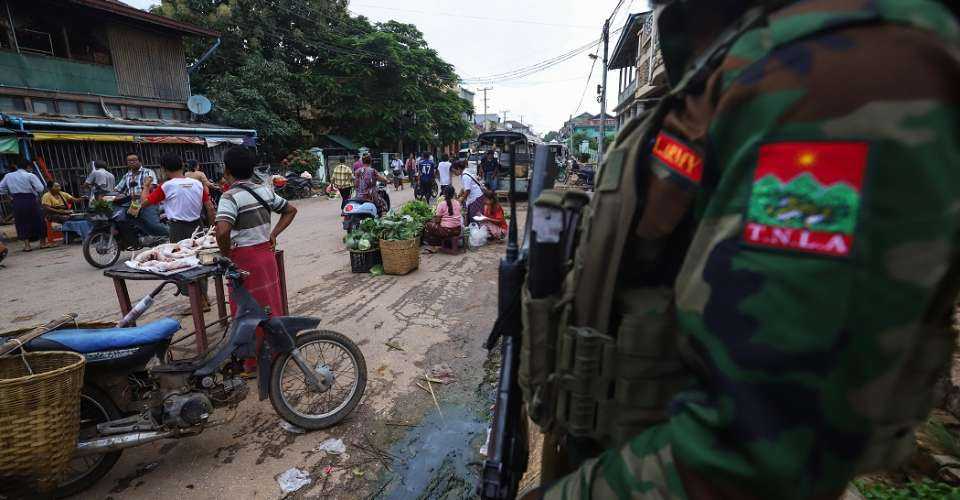
This photo taken on July 3 shows a member of the ethnic armed group Ta’ang National Liberation Army (TNLA) keeping watch as people buy groceries at a street market in Kyaukme in Myanmar’s northern Shan State. (Photo: AFP)
The United States Institute for Peace (USIP) is urging Washington and Delhi to make use of cross-border, alternative routes opening up in Myanmar by anti-regime forces and begin cooperating in the delivery of much-needed humanitarian assistance into the war-torn country.
Significant gains by ethnic armed organizations (EAOs) and the People’s Defence Force (PDF) since November have cost the junta control of nearly all of its borders, which USIP said raised the prospect that aid could now be ferried in from India.
“This will require the United States to invest time and effort in diplomacy with India to allow them access to the border area,” a USIP report said, adding United Nations, implementing partners and other humanitarian organizations would be ideal for delivering aid.
Congress has earmarked US$121 million in its 2024 budget for Myanmar-related programs, including $75 million for cross-border aid, with India named as a potential conduit into Myanmar where the military recently extended its state of emergency by another six months.
“This represents an opportunity to reduce human suffering for refugees and displaced people on both sides of the India-Myanmar border,” the USIP report said.
A US-India-led combination would help in alleviating some of the humanitarian concerns that are being all but ignored by Myanmar’s neighbors, including the remaining nine countries that make up the Association of South East Asian Nations (ASEAN).
At an ASEAN foreign ministers’ summit, held last month in Vientiane, Myanmar rated just a few mentions in a 16,700-word communique where ASEAN stated that its latest financial allocation for humanitarian assistance amounted to a paltry US$1.88 million.
The Thai government has pledged another US$250,000, to the ASEAN Coordinating Centre for Humanitarian Assistance and Disaster Management, also a miserable sum that falls far short of the help ordinary Thais have extended to millions of refugees who have fled across their border.
USIP and the UN, among others, say Myanmar’s humanitarian crisis is worsening, accusing the military of attempting to compensate for territorial defeats by punishing civilians with air strikes and large-scale arson attacks for almost a year.
Another three million people are internally displaced (IDPs) and in dire need of help among a population of 54 million people who have struggled with the travesties of a war inflicted by its own military — also known as the Tatmadaw — that has failed to impose its will and control.
Alice Wairimu Nderitu, UN Special Adviser on the Prevention of Genocide, and Mô Bleeker, UN Special Adviser on the Responsibility to Protect, have accused the Tatmadaw of renewed attacks on civilians since last October, when the EAOs-PDF were preparing their dry season offensive.
“These include beheadings, burning of villages, drone attacks and killings of unarmed people fleeing. There are reports that Rohingya as well as civilians from other minorities, are being used as human shields and conscripted into the armed forces and armed groups,” they said.
The devastation is harshest in northwest Myanmar where half the country’s IDPs are struggling in Chin state, Sagaing and Magway with physical access a consistent challenge and far removed from existing humanitarian operations primarily operating from the southeast.
However, recent victories by the Chin National Front and its allies in northern Chin state and the Arakan Army in western Rakhine state have left anti-regime forces in control of much of the border areas with India, which the USIP says presents new options for humanitarian operations.
“Taken together, Chin and Arakan forces have ended the Tatmadaw’s physical presence along much of Myanmar’s border with India, creating potential pathways for cross-border aid to reach isolated people in the war-torn northwest,” USIP said.
It’s an aid route that would have been impossible to tread a few months ago and still has its problems. Delhi is quite publicly competing with Beijing for influence with the Tatmadaw and is also threatening to close its border with Myanmar.
Unlike China, which has brokered ceasefires with the Arakan and Chin, India has ignored about 20 EAOs, the PDF, and the National Unity Government in exile in favor of the junta and is now facing the political realities for its backing of military chief Gen. Min Aung Hlaing.
However, other avenues are appearing in the wake of EAO-PDF successes on the battlefield, including the capture of Myawaddy in April by the Karen National Liberation Army on the Thai border, opposite the provincial town of Mae Sot.
What little assistance ASEAN has provided has been funneled across the Thai border alongside basic essentials via a network of volunteers and EAOs which USIP is urging UN agencies and aid groups to replicate in Myanmar’s northwest.
“While this will require coordination among donors and a nuanced approach to internal politics within the resistance, the chance to address northwest Myanmar’s humanitarian crisis should not be missed,” it said.
A further political option is via negotiations through a troika — Indonesia, Malaysia and Laos — established by ASEAN at the foreign ministers summit after its dismal failure to win support for its five-point peace plan from the Tatmadaw.
Laos’ inclusion is solely because of its current position as this year’s chair of ASEAN, but with Indonesia and Malaysia the troika — which has been touted for the last two years — is expected to broaden negotiations to include all EAOs, the PDF and NUG.
It’s a channel the Americans might pursue in terms of delivering aid into Myanmar, given Washington’s desire to improve relations with Indonesia which by far remains the region’s economic and political powerhouse. India could follow suit.
source : uca news
